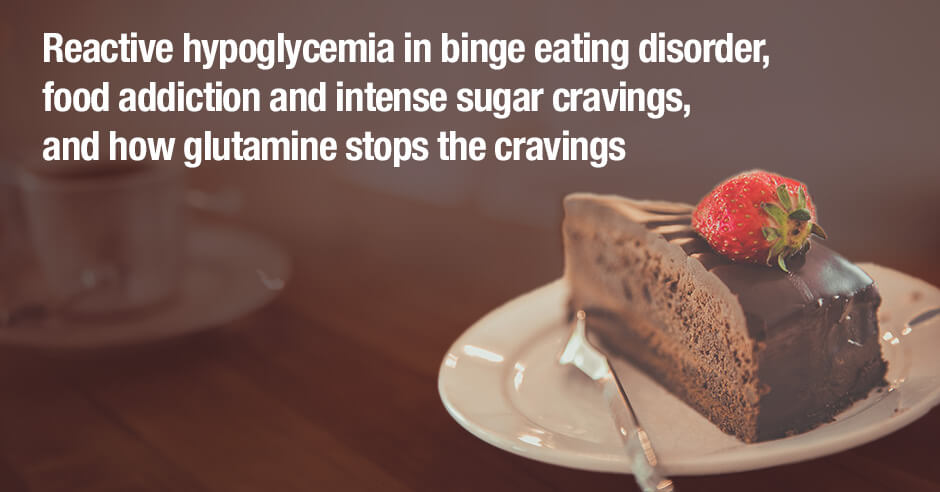
A number of years ago a woman came to see me looking for help for her anxiety, insomnia and out of control sugar cravings which she described as an “almost demonic urge to eat sugar and all things sweet.”
Before working with me she had been trying to control her low blood sugar levels (or hypoglycemia) by eating the right foods at the right times i.e. healthy fats and quality protein especially at breakfast. But this wasn’t enough to eliminate her intense sweet cravings. She would make and eat sweet treats all day long, using “healthier” sweeteners like monk fruit and maple syrup.
I had her complete the brain chemistry symptoms questionnaire and she scored high on all the low blood sugar symptoms as well as low GABA and low serotonin. We focused on low blood sugar first and the solution for her cravings was using 500 mg of glutamine opened onto her tongue.
Initially she was sure this would NOT work – how would she possibly be able to use glutamine in the midst of experiencing reactive hypoglycemia or low blood sugar?
I had the same conversation that I have with all my clients who would obviously rather eat something sweet than open a glutamine capsule onto their tongue: “If you have an intense craving for something sweet, tell yourself that you’re going to indulge, but also humor your nutritionist and take the glutamine anyway. You may be surprised to find your urge completely disappears.”
She did that and it worked time and time again, ending her demonic urge to eat something sweet every time and very quickly. And it helped her with all her low blood sugar symptoms.
This blog addresses the role of low blood sugar or reactive hypoglycemia in intense sugar cravings, binge eating disorder and food addiction, and how glutamine helps.
Research: Reactive hypoglycemia in binge eating disorder and food addiction
The 2023 paper, Reactive hypoglycemia in binge eating disorder, food addiction, and the comorbid phenotype: unravelling the metabolic drive to disordered eating behaviours, highlights the fact that “impaired metabolic response” such as fasting blood glucose fluctuations are a factor in binge eating and food addiction, driving out of control and “repetitive consumption of highly processed food.”
The researchers “investigated hypoglycemia events during a 5-hour-long oral glucose tolerance test” in 200 participants and “the association between the severity of eating psychopathology and the variability in hypoglycemia events was explored.”
The authors conclude as follows:
People with binge eating disorder/BED or food addiction/FA are prone to experiencing reactive hypoglycemia; food addiction severity may predict early and symptomatic hypoglycemia events. This can further reinforce disordered eating behaviours by promoting addictive responses, both biologically and behaviourally.
You can read the study here.
It’s worth noting that the participants did not have diabetes. I mention this because most of the reactive hypoglycemia research looks at diabetic patients. Reactive hypoglycemia in the non-diabetic population is considered controversial even amongst functional medicine and/or integrative practitioners. This paper stands out for this reason.
It’s also recently published which makes me excited. This research is confirming what we see clinically.
This research is very much in line with the demonic urge my client described, and directly tied to her low blood sugar and blood sugar swings. My client did not do a 5 hour oral glucose tolerance test. Instead we used the low blood sugar symptoms questionnaire (see below) and a trial of glutamine.
My client was also not diagnosed with binge eating disorder or food addiction but didn’t have to be for us to recognize the issue and have her benefit from nutritional support in the way of glutamine and learning to eat for blood sugar stability.
Unfortunately the authors do not discuss glutamine as a solution in this particular paper or in any other research on human participants who are non-diabetic. There are a few animal diabetes studies, with this 2013 study reporting that “glutamine was more effective in promoting glycemia recovery if compared with glucose, lactate, glycerol, or alanine.” The authors call for further investigations which I look forward to reading.
Low blood sugar symptoms and a glutamine trial
As a reminder here are the signs of low blood sugar:
Sugar cravings, binge eating and addiction symptoms:
- Crave sugar, starch or alcohol any time during the day
- Very intense cravings for sweets/sugar
- Binge eating and/or food addiction (updated with this based on this research)
There are also anxiety, mood, sleep and energy symptoms when you have low blood sugar:
- Nervous, anxious, panic attacks
- Irritable, shaky, headachey – especially if you go too long between meals
- Lightheaded if meals are missed
- Agitated, easily upset
- Eating relieves fatigue
- Waking in the night or early hours with a jolt of anxiety/shakiness (I blogged about this here)
As I mention in the waking with a jolt/low blood sugar blog the good news is it’s relatively easy to figure out if low blood sugar is causing your symptoms. First I have clients rate their symptoms on the low blood sugar questionnaire and do a trial of glutamine. Next is figuring out the dosing and timing of glutamine, looking at a current food log and making dietary changes as needed.
Glutamine is always best opened on to the tongue but it must be used this way for stopping the intense sugar cravings quickly – as in immediately. It’s also used away from meals like all the amino acids.
If you notice improvements it’s very likely that reactive hypoglycemia or low blood sugar is a factor.
Glutamine for low blood sugar cravings: dosing and timing
As I share in my book and other blog posts, typically 500 mg glutamine is a good starting dose for intense cravings for sugary foods. We may increase based on individual needs and you may find you do need to use 500 mg -1000 mg two to three times a day when the intense desire for something sweet strikes – as blood sugar dips. Using a glutamine powder is a great way to use it especially if you find you do need more than 500 mg each time.
As I mentioned above when you use glutamine powder directly on the tongue (rather than mixed in water), the benefits are seen almost immediately and even if you don’t believe it could possibly work – like my client – your desire for sugar disappears.
GABA and serotonin support too
My client also needed GABA and serotonin support for her anxiety and sleep issues. Again, we used the low GABA and low serotonin symptoms questionnaire and did trials of GABA and tryptophan for her which helped further.
Sugar cravings and binge eating with other neurotransmitter imbalances too
Keep in mind that there is a sugar cravings aspect to all the neurotransmitter imbalances. The type of craving can be found on the above symptoms questionnaire. It’s not uncommon to need support more than one area:
- Low blood sugar /hypoglycemia – glutamine for intense cravings at any time of the day
- Low serotonin – tryptophan or 5-HTP for afternoon/evening cravings
- Low endorphins – DPA for comfort/reward eating
- Low catecholamines – tyrosine for low energy sugar cravings
- Low GABA – GABA for stress eating
You can read more about this here: The individual amino acids glutamine, GABA, tryptophan (or 5-HTP), DPA and tyrosine are powerful for eliminating sugar cravings, often within 5 minutes
Glutamine product options – capsule vs powder
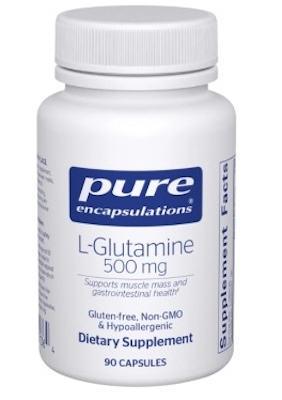
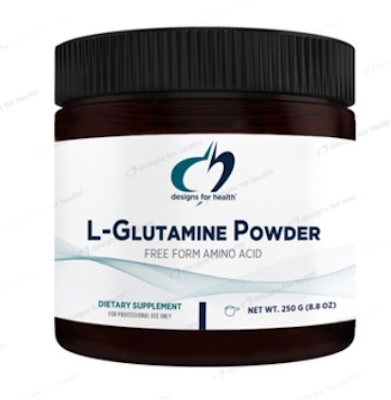
Products I recommend include Pure Encapsulations 500 mg l-glutamine (capsules opened on to your tongue) and Designs for Health l-glutamine powder as you find you need higher amounts. You can purchase these from my online store (Fullscript – only available to US customers – use this link to set up an account).
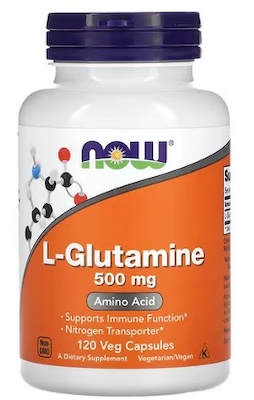
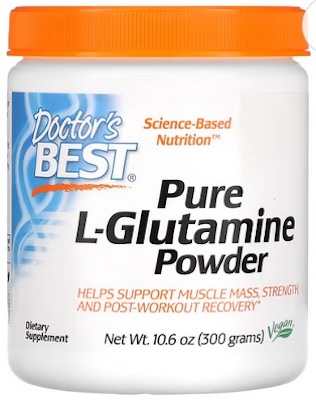
If you’re not in the US, Now l-glutamine 500 mg and Doctor’s best l-glutamine powder are products I recommend on iherb (use this link to save 5%).
Additional resources when you are new to using glutamine and other amino acids as supplements
We use the symptoms questionnaire to figure out if low blood sugar and/or low serotonin and/or low GABA and other neurotransmitter imbalances may be an issue for you.
If you suspect low levels of any of the neurotransmitters and do not yet have my book, The Antianxiety Food Solution – How the Foods You Eat Can Help You Calm Your Anxious Mind, Improve Your Mood, and End Cravings, I highly recommend getting it and reading it before jumping in and using amino acids on your own so you are knowledgeable. And be sure to share it with the practitioner/health team you or your loved one is working with.
There is an entire chapter on the amino acids and they are discussed throughout the book in the sections on gut health, gluten, blood sugar control (this is covered in an entire chapter too), sugar cravings, anxiety and mood issues. The importance of quality animal protein and healthy fats is also covered.
The book doesn’t include product names (per the publisher’s request) so this blog, The Antianxiety Food Solution Amino Acid and Pyroluria Supplements, lists the amino acids that I use with my individual clients and those in my group programs.
If, after reading this blog and my book, you don’t feel comfortable figuring things out on your own (i.e. doing the symptoms questionnaire and respective amino acids trials), a good place to get help is the GABA QuickStart Program (if you have low GABA symptoms too). This is a paid online/virtual group program where you get my guidance and community support.
If you are a practitioner, join us in The Balancing Neurotransmitters: the Fundamentals program. This is also a paid online/virtual program with an opportunity to interact with me and other practitioners who are also using the amino acids.
Have you had success with glutamine for blood sugar stability and binge eating, food addiction and intense cravings for sugar and carbs?
Have you also found it helps with sleep, leaky gut and anxiety during the day?
If yes, how much helps you? And how often do you use it? And what sugary foods have you been able to stop eating?
If you’re a practitioner do you use glutamine and with clients/patients with these low blood sugar cravings? Do you recognize reactive hypoglycemia as a very real issue in non-diabetics?
And please let me know if it’s helpful that I’m now including product recommendations and where to get them?
Feel free to share and ask your questions below.
Is a blood sugar reading of 105 at 330am considered high? I’ve been waking up at 330, almost on the dot for the past week… I’m not skakey or jittery. but can’t fall back asleep tho then everytime I’m almost drifting off, it’s like I get startled awake, have to take a deep breath and then heart feels poundy and anxious. My sugar reading at 630am when I get up for the day is around 85, which is really good I think? Is this a blood sugar issue?
Hilary
Are you using a CGM/continous glucose monitor? What is your reading before dinner and then a few hours after and right before bed? (And what are the times)?
Such interesting info, as always. Thank you!!
I quit taking L-glutamine a few years ago because I learned that, to oversimplify it, a higher percentage of it is not directly used and therefore is converted to calories or sugar (??) than other amino acids or protein sources… Whey protein and BCAAs are similar. I’m sure I don’t remember the details of that correctly – but the gist of it, as I understood it, was that glutamine could affect blood sugar in a way that might cause sensitive folks like me to gain weight … But it must be in a different way than I understood it and it sounds like it may be beneficial for me.
I also read an article recently about a woman who developed uncontrolled sugar cravings because of dementia.. Her brain was essentially desperately hungry for one of its main energy sources. There must be a connection here to metabolic imbalances of many kinds, which is very interesting.
I quit eating all sugars, processed foods, dairy and almost all carbs over 20 years ago, in my mid-late 20s, and for a long time after, I never craved anything, let alone sweets. When I was younger, I did have intense sugar cravings and would sometimes binge uncontrollably on sweets. I learned to never have them around. Once I switched my diet to protein, veg and healthy fats, that went away – until I had a relapse into chronic illness.
In the last several years, I have struggled with MCAS, migraines and even brain swelling, along with intense adrenal fatigue, and my sugar cravings have come back, in spite of almost never eating anything sweet. I’ve also been somewhat immobilized with loads of injuries and ortho surgeries, which I believe contributed. I live alone and never have sugar or processed foods in my home, and yet just seeing a picture of sweets online would make me intensely crave sweets. It was such a departure from my many years of never craving anything, even when I was at a dinner party and everyone around me was indulging, that I knew it was significant. I trust my body and believe that if it’s craving something, there’s a deficiency or a need that’s being expressed. I will allow myself to eat salt, healthy fats and protein when I feel those cravings, but not sweets, even when I feel like I’m craving sweets.
I’m going to try the glutamine solution and see if this helps. This is such great info.
Ava
I don’t know of evidence that points to glutamine causing weight gain. If you have a study or article link please do share it. And yes sugar cravings are common in dementia and may be due to low blood sugar or another neurotransmitter imbalance.
Good for you for quitting sugar and processed foods. Not having any around is one thing but still craving them makes it very hard (and things can shift when we are ill)- this is where glutamine and the other amino acids shine.
Be sure to review the symptoms questionnaire and please keep us posted on progress.
Hey Trudy, do you have any hint, lab factor or study which brings an explanation what is different in these people? They are not diabetic but have huge pos. and neg. spikes in their blood sugar which is very different form normal control of blood or energy status. Where goes all the energy of the sweets to? What do you think about the mental side of this abnormal reaction?
By the way I’m a nutritionist and I have a case of this kind currently. Can I get the mentioned questionnaire for brain chemistry symptoms from you?
Michael
I start with all the basic blood work and 4 collection cortisol (adrenal issues are common). Genetics can be a factor too.
Here is the questionnaire https://www.everywomanover29.com/blog/amino-acids-mood-questionnaire-from-the-antianxiety-food-solution/
And the practitioner training if you’re interested in amino acids for your clients https://www.anxietynutritioninstitute.com/balancingneurotransmitters/